
Bismarck is a board wargame published by Avalon Hill in 1962 (and revised in 1978) that simulates the hunt for the Bismarck.

Bismarck is a board wargame published by Avalon Hill in 1962 (and revised in 1978) that simulates the hunt for the Bismarck.
Bismarck is a two-player board wargame in which one player controls the German battleship Bismarck (and in the 1972 edition, the heavy cruiser Prinz Eugen), and the other player the British forces hunting for it.
The game box contains a search board and a battle board, both utilizing a square grid, along with zone cards, die-cut counters representing a large number of British units, and one single German counter, the Bismarck.
The game uses a double-blind system, where the British search areas and zones of the map for the Bismarck. If the British player discovers the location of the Bismarck, combat takes place on the battle board. The Bismarck has a chance to evade combat, restarting the search. Points are gained by both players for destroying ships, and for the German player, for docking in friendly ports.

The 1978 edition has some similarities to the game Battleship , with both players having a hidden map-board and calling out coordinates to locate their opponent. The British player sets up a large number of Royal Navy vessels and search aircraft on their map-board before game play begins, while the German player places the Bismarck and the Prince Eugen on their mapboard. [1]
Each turn, the players move their respective units, searching for enemy units, and possibly engaging in combat. Each player calls out grid coordinates containing a ship or aircraft, and the opponent indicates whether a ship is located there, and if so what type. A player may choose not to search with a particular unit, thus keeping its location secret. As the British are unlikely to have a force sufficient to sink the Bismarck when they initially find her, they will need to "shadow" the vessel. For example, a fast unit such as the heavy cruiser HMS Suffolk, is able to keep up with Bismarck and follow her on radar without engaging in combat. [1]
Eventually, British heavy units, such as the battlecruiser HMS Hood may be vectored into the same square as the German Task Force. At this point combat ensues. The British also have air units on the aircraft carriers HMS Victorious and HMS Ark Royal which can both search for the Germans and attack with torpedoes from a distance. The game has combat damage sheets with squares representing areas of each warship that can be damaged in combat. As combat is resolved, squares are checked off. [1]
The 1978 edition also included Intermediate Rules provide a set of modular additions, such as a more sophisticated weather system, submarines and destroyers, fighter aircraft, alternate "what if" scenarios (such as the German aircraft carrier Graf Zeppelin, breakout with the Tirpitz, French and U.S. forces, etc.), and more. The Advanced Rules implement ship-to-ship combat using a miniatures-type system, with ship counters laid out on the floor, realistic damage to ships, etc. [1]
The game offers eight scenarios: one historical scenario, and seven "what if?" scenarios. [2]
The Germans win by avoiding contact with the British, successfully "breaking out" into the Atlantic and ravaging merchant shipping there. They can also achieve victory by destroying any opposition they encounter and making their way to a friendly port in Occupied France.
The British win by intercepting and destroying the Bismarck.
Bismarck was designed by Thomas Shaw, Charles S. Roberts, Mick Uhl, and Jack Greene, and was published by Avalon Hill in 1962. This edition was discontinued in 1972. [3]
In 1978, Jack Greene revised the rules, making the relatively simple search, movement and combat systems more complex. This second edition, with new cover art and components, was published in 1978. [3]
In 1988, Joel Billings and John Lyon created a computer game titled Computer Bismarck based on the Avalon Hill game. (Thomas Shaw, vice-president of Avalon Hill, turned down Billings when he approached the game company about producing computer games for them.) Computer Bismarck would become the first game produced by Strategic Simulations Inc. (SSI), the new company co-founded by Billings and Lyon. [4]
Writing about the 1962 edition in Issue 8 of Games & Puzzles , Don Turnbull called the game "an approximate simulation" because it left out the Prinz Eugen. Turnbull considered the game a failure, saying, "It had some, but not much, merit; certainly anyone who thinks Bismarck will simulate naval action any more than roughly would be disappointed." [5]
In The Playboy Winner's Guide to Board Games , John Jackson noted that the 1962 edition was "easy to grasp and is, for a wargame, quite short — an hour or two at most." He noted that "It is even possible for the German player to win, occasionally, if the Bismarck can elude its pursuers for a while and can catch one or two of the British ships alone at night." [6]
In the 1980 book The Complete Book of Wargames , game designer Jon Freeman called the original 1962 edition "probably the best — and shortest — introductory wargame on the market at the time." However, Freeman didn't feel that the new (1978) edition was "occupying the same niche. It's still a good game; it's just aimed at a broader audience." He concluded by giving the second edition an Overall Evaluation of "Very Good." [2]
In a retrospective review in Issue 9 of Vieille Garde, Stephane Martin gave a lengthy breakdown of the gameplay in the second (1978) edition, and concluded, "Bismarck still remains today a quality reference in naval simulation games. With a little luck, it is possible to find this second-hand game at a very reasonable price." [1]
In another retrospective review, Joe Scoleri noted in Issue 3 of Simulacrum that "Bismarck was one of the easiest and quickest playing [Avalon Hill] Classics but is obviously limited in terms of realism and simulation value." Scoleri concluded, "Although the original version is perfectly acceptable as an introductory game, naval warfare enthusiasts will want to stick with the second edition." [7]
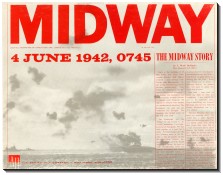
Midway is a board wargame published by Avalon Hill in 1964 that simulates the Battle of Midway during World War II.

B-17, Queen of the Skies is a solitaire board wargame published by On Target Games in 1981 that simulates flight missions in a Boeing B-17F Flying Fortress bomber during World War II. The game was acquired by Avalon Hill and republished in 1983.

PanzerBlitz is a tactical-scale board wargame published by Avalon Hill in 1970 that simulates armored combat set on the Eastern Front of World War II. The game, which was the most popular board wargame of the 1970s, is notable for being the first true board-based tactical-level, commercially available conflict simulation wargame. It also pioneered several concepts that would become industry standards.

Jutland is a naval board wargame published by Avalon Hill in 1967 that simulates the Battle of Jutland in the North Sea during World War I. Upon its release, Jutland was commended for its gameplay and mechanics, but criticism surrounded the complex rules and playing time.

Battle of the Bulge is a board wargame published by Avalon Hill (AH) in 1965 that simulates the World War II battle of the same name. General Anthony McAuliffe (ret.), who had been commanding officer at Bastogne during the Battle of the Bulge, was a consultant during the game's development. The game proved popular and sold more than 120,000 copies, but was dogged by criticisms of historical inaccuracies, and was finally replaced by a completely new edition in 1981. A third edition in 1991 was released as part of the Smithsonian American History Series.
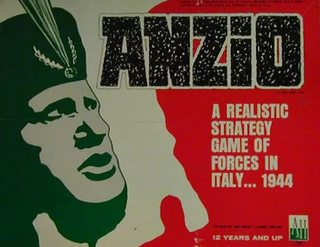
Anzio is a board wargame published by the Avalon Hill game company first in 1969 and again in 1971, 1974, and 1978. The title is misleading as the game is not an operational-level treatment of the Battle of Anzio but is in fact a strategic level game covering the entire Italian theater of operations in World War II from the autumn of 1943 to the end of the war in Europe.

Hitler's War is a strategic level World War II war game for 2 or 3 players, first published by Metagaming Concepts in 1981, and then by Avalon Hill in 1984.
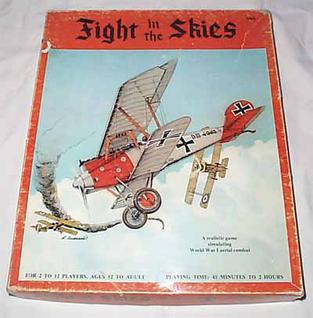
Fight In The Skies, also known as Dawn Patrol, is a board wargame first self-published by creator Mike Carr in 1966, then published by Guidon Games in 1972 and TSR in 1975. The game simulates World War I style air combat, and is the only game to appear on the event schedule of every Gen Con convention since Gen Con I.
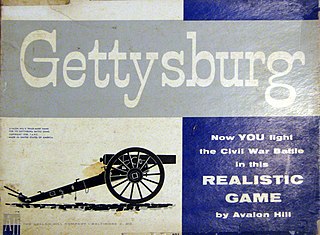
Gettysburg is a board wargame produced by Avalon Hill in 1958 that re-enacts the American Civil War battle of Gettysburg. The game rules were groundbreaking in several respects, and the game, revised several times, was a bestseller for Avalon Hill for several decades.
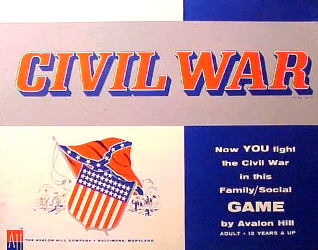
Civil War is an early strategic board wargame published by Avalon Hill in 1961 that simulates the American Civil War. Unlike other games produced by Avalon Hill during this period such as Gettysburg, Civil War did not sell well and was dropped from production two years later.

Computer Bismarck is a computer wargame developed and published by Strategic Simulations, Inc. (SSI) in 1980. The game is based on the last battle of the battleship Bismarck, in which British Armed Forces pursue the German Bismarck in 1941. It is SSI's first game, and features turn-based gameplay and two-dimensional graphics.

Arcola, The Battle for Italy 1796 is a board wargame published by Operational Studies Group (OSG) in 1979 and republished by Avalon Hill in 1983 that is a simulation of the Battle of Arcola between French and Austrian forces in 1796. The game was designed to tempt players to purchase OSG's previously published and larger wargame Napoleon in Italy.

The Game of France, 1940: German Blitzkrieg in the West, originally titled "The Battle for France, 1940", is a board wargame originally published by Simulations Publications Inc. (SPI) in 1971 that was subsequently re-issued by Avalon Hill in 1972. Both editions simulate the World War II Battle of France in 1940, when the German blitzkrieg offensive overwhelmed French and British defenses in northern France.

KampfPanzer: Armored Combat, 1937–40 is a board wargame published by Simulations Publications Inc. (SPI) in 1973 that simulates the first battles involving battle tanks.
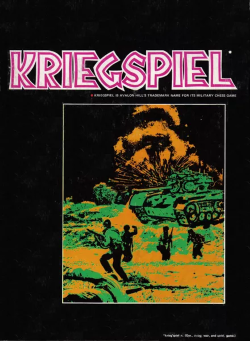
Kriegspiel is a board wargame published by Avalon Hill in 1970 that simulates a hypothetical war between two nations. Although the simple game sold well to new players, it received negative reviews by more experienced gamers.

MechWar '77, subtitled "Tactical Armored Combat in the 1970s", is a board wargame published by Simulations Publications Inc. (SPI) in 1975 that simulates hypothetical tank combat in the mid-1970s between various adversaries, using the same rules system as the previously published Panzer '44.

Eagle Day: The Battle of Britain is a board wargame published by Histo Games in 1973 that simulates the Battle of Britain. Reviewers noted its marked similarity to previously published wargames The Battle of Britain, and Luftwaffe, but found Eagle Day to be inferior to both.
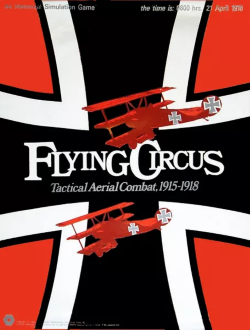
Flying Circus, subtitled "Tactical Aerial Combat, 1915–1918", is a board wargame published by Simulations Publications Inc. (SPI) in 1972 that simulates aerial combat during World War I.
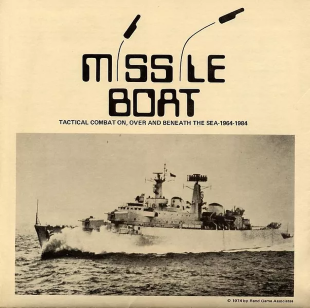
Missile Boat, subtitled "Tactical Combat On, Over and Beneath the Sea 1964-1984", is a board game published by Rand Game Associates (RGA) in 1974 that simulates naval combat using ships and weaponry from the mid-1960s to the mid-1980s.
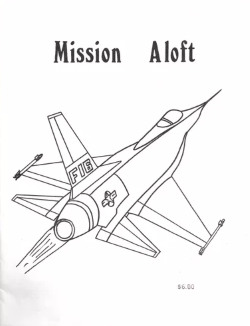
Mission Aloft is a board wargame published by Jim Bumpas in 1977 that simulates aerial missions against ground targets in the 1960s and 70s.